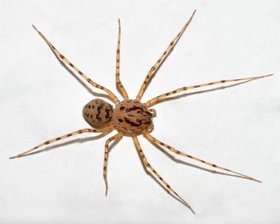
November 11, 2010
From 2006…one of our most popular postings…with more comments from 2008…

Camel spiders found during the Iraq war. They are real. What do I mean by real?
Jeremy Miller was hunting black widow spiders in a Madagascar forest last winter (of 2005) when he came upon a curious fist-size web made of leaves, branches and debris woven together with thin, tough strands of spider silk. No black widow ever made such a web, but when Miller examined the tiny creatures inside, he realized he’d discovered a new species of “spitting spider.”
Thus begins the article in the San Francisco Chronicle of July 22, 2006, on the exciting find of a new animal, a spitting spider, Scytodes specialis.

Pictured above is the new species’ relative, another spitting spider, Scytodes thoracia.
Of course, finding new insects and spiders happens all the time. But my internal definition of cryptid, especially as captured in Cryptozoology A to Z, is that cryptids are big enough to visually have an impact on humans. Thus, when I read about new little spiders, it makes me wonder…what stories are out there about truly giant spiders?
Bizarrely, the war in Iraq is generating such stories. It seems soldiers have been seeing and killing “spiders” they call “camel spiders.” At the top of this posting is a photograph of two camel spiders that has been circulated a great deal on the internet.
Here’s what is being posted across cyberspace about these giant Iraqi camel spiders, so-called because they are said to jump on camels’ stomachs and lay their eggs inside for hatching:
Some facts about those giant spiders: They run 10 mph, jump three feet, are a nocturnal spider, so only come out at night unless they are in shade. When they bite you, you are injected with Novocain so you go numb instantly. You don’t even know you are bitten when you are sleeping, so you wake up with part of your leg or arm missing because it has been gnawing on it all night long. If you are walking around and you bump something that is casting a shadow over it, and the sun makes contact with it, you better run. It will instantly run for your shadow, and scream the whole time it is chasing you. PS. These are Spiders found daily in Iraq by troops. Imagine waking up and seeing one of these in your tent!! Spread this to all your friends who have a family member in the army, and let them know what kind of daily life they live everyday! Hopefully someone high in our government will start thinking about our troops’ lives, and they’ll be back home safe real soon!
Facts? Nope. Eggs in camels’ stomachs? Never.

The above camel spider factoids are myth, mixed in with one real photograph of two real arachnids (at the very top of this posting) and a few hoaxed ones (directly above). These animals are technically what are called solifugids, but are more commonly known as wind or sun scorpions or camel spiders. The eight-legged solifugids have no venom glands, and the largest species is no more than 6 inches long with its legs outstretched. Apparently, some people even keep them as pets. You can read more about them in this National Geographic article, which also talks about a new species of wind scorpion recently discovered in Mexico.
Classically, the most exotic Giant Spider sightings have come from Africa. Various Mokele-mbembe expedition members have brought back tales from the Congo of Giant African Spiders, known among the Baka pygmies, and said to be at least 10 inches across. Some are vague tales of missionaries knowing about porters being killed by giant spiders. Others tell of the giant spiders being reported under tents, crossing trails, and running through campsites. For everyone that was thinking about going on a Mokele-mbembe trek soon, they didn’t tell you about that, did they?
Perhaps most well-known is one clear story of the really large ground-dwelling spider collected by Mokele-mbembe researcher Bill Gibbons, who writes:
I first became aware of a giant ground-dwelling spider through Miss Margaret Lloyd, formerly of Rhodesia and now living in England. Her parents, Reginald and Margurite Lloyd were exploring the interior of the old Belgian Congo in 1938 when they spotted something crossing the jungle track ahead of them. At first they took the object to be a large jungle cat or a monkey on all fours. When they stopped their vehicle (an old Ford truck) to allow the animal to pass, they were thunderstruck to see that it was a very large brown spider, similar in its appearance to a tarantula, with a leg span of at least four or five feet. Mr. Lloyd trembled so much with excitement that he was unable to retrieve his camera in time to take a snap, and Mrs. Lloyd was so distraught that she wanted to return home (Rhodesia) immediately. This creature is known as the J’ba Fofi; J’ba meaning “great” or “giant” Fofi meaning “spider” (spiders of all kinds are called Fofi).
Are there other historical or contemporary Giant Spider sightings from Africa?
Cryptomundo correspondent Todd Partain writes with this new old sighting, collected during July 2006:
Just a couple of days ago, my own father related this story from his childhood, and I immediately grabbed a notebook and started jotting down facts….
One cool night in 1948, in Leesville, Louisiana, 48-year-old William Slaydon walked his wife, Pearl, and his three grandsons to church. Among them was the youngest, Richard Partain, a child of six at the time. They walked north along Highway 171, and as the road began to dip, Grandpa Slaydon suddenly stopped his grandchildren with a gesture and had them step back quietly and freeze.
The grandchildren, aged six to thirteen, knew instinctively to obey this gesture without question. There was a rustling from the ditch, and an unbelievable creature emerged from the darkness.
Richard Partain described: “It was a huge spider, the size of a washtub. It was hairy and black. No one, not even my grandmother, said a word.”
As they watched, the giant arachnid crossed the asphalt from East to West, and disappeared into the brush on the opposite side of the highway.
“We asked Grandpa what it was, and he said simply that it was a very large spider.”
Afterwards, all nighttime walks by the family to the church were cancelled. The incident was never discussed again with the grandchildren.
“Through my whole life, whenever I watched a TV program or read an article about spiders, I would wait for someone to identify it, but no one ever has,” said Richard. “I always had the impression that Grandpa was familiar with them, that had seen one before, or at least knew about them.”
Bill Slaydon, born on the turn of the century, was a man that had lived in the deep woods, building makeshift slab towns at whatever spot was necessary to facilitate the logging industry of the time. It’s likely that were quite a few anomalies the loggers were tight lipped about, especially around the kids.
What was seen in Louisiana in 1948? An escapee from a banana boat or an unidentified and unknown new species?
The goliath bird-eating tarantula (Theraphosa blondi) from Surinam, Guyana, French Guiana, Venezuela, and Brazil use to be said to be the world’s largest species. Today, the pinkfoot goliath tarantula (Theraphosa apophysis), which was discovered 187 years after the goliath birdeater, takes the prize in size. Some of these have legspans of up to 13 inches long. The males of most tarantulas are longer legged than the females.
Are larger ones to be found?
Are there new species of spiders out there that are bigger than dinner plates or a washtub?
+++
The comments below are from the original 2006 and 2008 postings, and have been retained for discussion purposes.
About Loren Coleman
Loren Coleman is one of the world’s leading cryptozoologists, some say “the” leading living cryptozoologist. Certainly, he is acknowledged as the current living American researcher and writer who has most popularized cryptozoology in the late 20th and early 21st centuries.
Starting his fieldwork and investigations in 1960, after traveling and trekking extensively in pursuit of cryptozoological mysteries, Coleman began writing to share his experiences in 1969. An honorary member of Ivan T. Sanderson’s Society for the Investigation of the Unexplained in the 1970s, Coleman has been bestowed with similar honorary memberships of the North Idaho College Cryptozoology Club in 1983, and in subsequent years, that of the British Columbia Scientific Cryptozoology Club, CryptoSafari International, and other international organizations. He was also a Life Member and Benefactor of the International Society of Cryptozoology (now-defunct).
Loren Coleman’s daily blog, as a member of the Cryptomundo Team, served as an ongoing avenue of communication for the ever-growing body of cryptozoo news from 2005 through 2013. He returned as an infrequent contributor beginning Halloween week of 2015.
Coleman is the founder in 2003, and current director of the International Cryptozoology Museum in Portland, Maine.
Filed under Breaking News, Cryptomundo Exclusive, Cryptotourism, CryptoZoo News, Cryptozoologists, Cryptozoology, Expedition Reports, Eyewitness Accounts, Folklore, Living Dinosaurs, Megafauna, Pop Culture